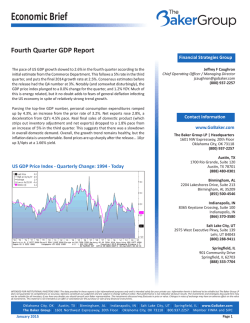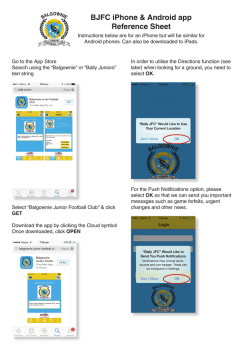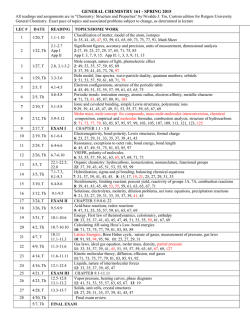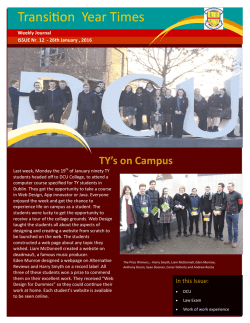
REPORTED IN THE COURT OF SPECIAL APPEALS
REPORTED IN THE COURT OF SPECIAL APPEALS OF MARYLAND No. 2494 September Term, 2013 D EANN BAKER v. CHRISTOPHER A. BAKER Woodward, Arthur, Rodowsky, Lawrence F. (Retired, Specially Assigned), JJ. Opinion by Arthur, J. Filed: February 2, 2015 This case concerns the interpretation of an agreement to divide marital property in connection with a divorce. The case specifically concerns whether the wife relinquished her interest in a capital-loss carry-forward that resulted from activity in the couple’s jointly-titled investment accounts when she relinquished any interest “in” the accounts themselves. Holding that she had, the Circuit Court for Anne Arundel County directed the entry of summary judgment in her ex-husband’s favor. We shall reverse. Q UESTIONS P RESENTED Ms. Baker presents several questions and sub-questions for our review, which we restate as follows: I. Did the circuit court err in denying Ms. Baker’s motion for summary judgment on the ground that the marital property agreement unambiguously entitled Mr. Baker to 100 percent of the capital-loss carry-forward as an interest in the couple’s jointlyowned investment accounts? II. Alternatively, did the circuit court err in not finding an ambiguity in the agreement as to how the capital-loss carry-forward should be divided, thus precluding summary judgment for either party and requiring a trial on the facts? III. Should this Court, if it reverses and remands in Ms. Baker’s favor on the issue of breach of contract, reinstate Mr. Baker’s prior alternative claim of unjust enrichment? 1 1 Ms. Baker originally phrased her questions in the following manner: I. With respect to the Property Settlement Agreement: A. Did the trial court err in denying Ms. Baker’s motion for summary judgment because each divorced party is entitled to 50 percent of a capital loss carry forward which (continued...) For the reasons that follow, we answer affirmatively as to the first issue, reverse the circuit court’s judgment, and direct the court to enter summary judgment in Ms. Baker’s favor. We find it unnecessary to reach the second issue, as the agreement was not ambiguous. As to the third issue, we hold that Mr. Baker cannot reassert a quasicontractual claim for unjust enrichment when he is bound by an express, written contract. F ACTUAL AND P ROCEDURAL H ISTORY I. Terms of Divorce Agreement Christopher and DeAnn Baker were divorced in the Circuit Court for Anne Arundel County on September 15, 2010. Their Voluntary Separation and Property Settlement Agreement (the “Agreement”) was incorporated, but not merged, into the judgment of absolute divorce. The Agreement addressed the issues of alimony, child support, child custody, the 1 (...continued) originated from equally owned jointly owned assets and the agreement did not provide to the contrary? II. B. Did the trial court err in sua sponte concluding that the agreement unambiguously transferred the entire capital loss carry forward to Mr. Baker where the agreement is silent on the issue? C. Alternatively, did the trial court err in not finding an ambiguity in the agreement which would have precluded summary judgment for either party? Should the claim for unjust enrichment be reinstated where the issue is one of contract? -2- division of marital property, and visitation. It allocated various parcels of real estate to one spouse or the other and, in the case of one parcel, arranged for it to be sold and for the proceeds (and capital gains) to be equally divided. Similarly, the Agreement set the terms for the division of the parties’ automobiles and their personal property. In addition, the Agreement required Mr. Baker to pay $1.135 million to Ms. Baker, as a monetary award, over the course of five years. Section 19 of the Agreement set the terms for allocation of the couple’s investment accounts. Section 19.02, which forms the crux of this dispute, states as follows: Wife hereby relinquishes to Husband any interest she might have in any jointly titled investment or bank accounts. It is agreed that Wife shall promptly sign whatever assignments, waivers, or other documents are reasonably necessary to effect a transfer of interest from both parties into the sole and exclusive ownership of Husband. Husband shall be solely responsible for any loans associated with or secured by those accounts. II. The Capital-Loss Carry-Forward At the time of the divorce, the parties had a capital-loss carry-forward that resulted from losses in their investment accounts. The carry-forward came about because the Internal Revenue Code (the “I.R.C.”) limits the amount of a capital loss that taxpayers may use to reduce their tax liability in any given year, but allows taxpayers to defer (or carry-forward) the excess loss to reduce tax liabilities in future years. Hence, a capitalloss carry-forward is, in essence, a kind of a deferred tax-benefit. To illustrate, if an individual taxpayer generates a capital loss (i.e., the loss from -3- the sale or exchange of any capital asset) in a given year, the taxpayer, to reduce a tax liability, may offset the loss against any capital gains from that year. If the taxpayer’s aggregate losses exceed the capital gains in that year, he or she may also deduct up to $3,000.00 of the excess loss against ordinary income. See I.R.C. § 1211(b). The taxpayer then may “carry forward” any unused capital losses to the following year. See I.R.C. § 1212(b). In each future year in which that carried-forward loss remains, the taxpayer again may offset the loss against future capital gains, and against up to $3,000.00 of ordinary income, until all losses are exhausted or until the taxpayer dies. As a leading treatise explains: When carried forward, capital losses retain their short- or long-term character and are treated as sustained in the year to which they are carried. They are amalgamated with losses actually sustained in the year to which they are carried in determining the taxpayer’s net capital gains and losses and the amount to be deducted from ordinary income. Like losses actually sustained in the carryover year, they must be used to the extent possible even if it could be more advantageous to hold them in abeyance for use in a later year. . . . Unused capital loss carryovers expire on the taxpayer’s death. 2 Boris I. Bittker & Lawrence Lokken, Federal Taxation of Income, Estates & Gifts ¶ 46.2.6 (3d ed. 2000) (footnotes omitted). III. The Litigation Over the Capital-Loss Carry-Forward After the divorce, Ms. Baker used about 50 percent of the capital-loss carry- forward to offset the gains that she realized from the sale of the one of the couple’s parcels of real property. Contending that he alone had the sole right to the carry-forward, -4- Mr. Baker filed suit in the Circuit Court for Anne Arundel County on January 23, 2012. He alleged breach of contract and unjust enrichment and requested a declaratory judgment, as well as an award of attorneys’ fees under the Agreement.2 A year later, after a reasonable period of time for discovery, Ms. Baker moved for summary judgment. In support of her motion, Ms. Baker argued that, under the unambiguous language of the Agreement, she had not relinquished her interest in the capital-loss carry-forward because it was an interest separate and apart from the couple’s jointly-titled investment accounts. Mr. Baker opposed the motion, arguing that the Agreement was ambiguous. On July 15, 2013, the court heard argument on the motion. At the hearing, Mr. Baker shifted ground, arguing that the agreement was not ambiguous and that, under its unambiguous terms, his ex-wife had relinquished her interest in the carry-forward. The circuit court agreed with Mr. Baker, holding that the text of the Agreement unambiguously allocated the capital-loss carry-forward to him. It memorialized its ruling in a written order dated August 21, 2013, which left open the determination of the award of attorney’s fees to Mr. Baker as the prevailing party. Because the court had found in Mr. Baker’s favor on the breach of contract claim, it dismissed his unjust enrichment claim as moot. 2 Mr. Baker’s pleadings included a request for modification of child support. The parties settled their dispute on that issue, and it does not form any part of this appeal. -5- After the parties reached agreement on the amount of Mr. Baker’s damages because of his ex-wife’s use of the carry-forward ($43,370.00) and the amount of his attorneys’ fees ($8,668.00), the court entered a final judgment. Ms. Baker then filed a timely notice of appeal to this Court. D ISCUSSION I. Circuit Court Erred in Entering Summary Judgment in Favor of Mr. Baker Ms. Baker challenges the circuit court’s decision to grant summary judgment in her husband’s favor on the issue of breach of contract. In brief summary, she argues that the capital-loss carry-forward is a tax asset that, by operation of law, was distributed equally to her and Mr. Baker upon their divorce and that nothing in the Agreement dictates otherwise. Mr. Baker, by contrast, principally argues that the carry-forward is an interest in the jointly-titled investment accounts that his ex-wife unambiguously relinquished to him under the express terms of the Agreement. Because we conclude that the carry-forward is, as a matter of law, not an “interest in” the jointly-titled investment accounts within the meaning of section 19.02 of the Agreement, we reject Mr. Baker’s interpretation and hold that the circuit court erred in directing entry of summary judgment against his ex-wife. A. Standard of Review For motions for summary judgment, the applicable legal standards are well known: under Rule 2-501(f), “[t]he court shall enter judgment in favor of or against the moving -6- party if the motion and response show that there is no genuine dispute as to any material fact and that the party in whose favor judgment is entered is entitled to judgment as a matter of law.” “[T]he summary judgment standard is akin to that of a directed verdict, i.e., whether a fair-minded jury could return a verdict for the plaintiff on the evidence presented.” Seaboard Sur. Co. v. Richard F. Kline, Inc., 91 Md. App. 236, 244 (1992); accord May v. Air & Liquid Sys. Corp., 219 Md. App. 424, 429 (2014). Thus, a court must view the facts, and all reasonable inferences that may be drawn from them, in the light most favorable to the non-moving party. May, 219 Md. App. at 429; Dobkin v. Univ. of Baltimore Sch. of Law, 210 Md. App. 580, 590-91 (2013). Nonetheless, when a movant has carried its burden of demonstrating sufficient grounds for summary judgment, “‘the party opposing summary judgment must do more than simply show there is some metaphysical doubt as to the material facts.’” Hamilton v. Dackman, 213 Md. App. 589, 606 (2013) (quoting Seaboard Sur. Co., 91 Md. App. at 244); accord May, 219 Md. App. at 430. “In reviewing the grant of a motion for summary judgment, appellate courts focus on whether the circuit court’s grant of the motion was legally correct.” Sierra Club v. Dominion Cove Point LNG, L.P., 216 Md. App. 322, 330 (2014) (citing Laing v. Volkswagen of Am., Inc., 180 Md. App. 136, 152-53 (2008)); accord May, 219 Md. App. at 430. Thus, we conduct a plenary, de novo review of the grant of summary judgment. -7- See, e.g., May, 219 Md. App. at 430; Reiner v. Ehrlich, 212 Md. App. 142, 151, cert. denied, 433 Md. 514 (2013); Dobkin, 210 Md. App. at 590-91. B. Capital-Loss Carry-Forwards and Marital Property In the absence of any agreement, the United States Treasury regulations specifically provide that if spouses file separate returns after having previously filed a joint return, any capital-loss carry-forward is “allocated to the spouses on the basis of their individual net capital loss which gave rise to such capital loss carryover.” Treas. Reg. § 1.1212-1(c)(1)(iii).3 In other words, if spouses stop filing joint returns, any capital-loss carry-forward is divided between them in proportion to the extent to which their individual losses gave rise to the carry-forward. Id. In the case of jointly-titled assets in which the spouses had an equal interest, this would mean that the carry-forward would be divided equally between them. Nonetheless, most courts have held that a capital-loss carry-forward is a form of marital property, which the spouses can allocate between themselves at the time of a 3 Treasury Regulation § 1.1212-1(c)(1)(iii) states in full: If a husband and wife make separate returns for the first taxable year beginning after December 31, 1963, or any prior taxable year, and they made a joint return for the preceding taxable year, any capital loss carryover from such preceding taxable year shall be allocated to the spouses on the basis of their individual net capital loss which gave rise to such capital loss carryover. The capital loss carryover so allocated to each spouse may be carried forward by such spouse to the taxable year in accordance with paragraph (a) or (b) of this section. -8- divorce. See, e.g., Mills v. Mills, 663 S.W.2d 369, 372 (Mo. Ct. App. 1983) (ruling that “court did not err in finding the . . . capital loss carry forward was marital property”); Finkelstein v. Finkelstein, 701 N.Y.S.2d 52, 54 (N.Y. App. Div. 2000) (concluding “that a capital loss carry forward accumulated by the parties constituted a marital asset subject to distribution”); see also Magee v. Garry-Magee, 833 N.E.2d 1083, 1092-93 (Ind. Ct. App. 2005) (concluding that capital-loss carry-forward was property subject to distribution in divorce proceeding); cf. Haley v. Haley, 936 So. 2d 1136, 1139-40 (Fla. App. 2006) (capital-loss carry-forward was not marital property and could not be allocated among divorcing spouses where loss arose from property that was not a marital asset). We agree that a capital-loss carry-forward, when generated by a capital loss from the sale of marital property, is itself marital property, which the spouses can agree to allocate as they wish at the time of a divorce. Consequently, the question in this case becomes whether the Agreement allocates the capital-loss carry-forward between Mr. and Ms. Baker. If it does, the terms of the Agreement govern; if it does not, the background principles of law in the Treasury Regulations allocate the carry-forward between the spouses in proportion to the extent to which their individual losses gave rise to the carryforward. C. Section 19.02 Unambiguously Does Not Allocate the Carry-Forward to Mr. Baker Accepting Mr. Baker’s arguments, the circuit court held that section 19.02 of the Agreement unambiguously allocated the carry-forward to him. We agree that section -9- 19.02 is unambiguous, but disagree that that provision allocates the carry-forward to Mr. Baker. “[T]he determination of ambiguity is one of law, not fact, and that determination is subject to de novo review by the appellate court.” Calomiris v. Woods, 353 Md. 425, 434 (1999); accord Ocean Petroleum Co., Inc. v. Yanek, 416 Md. 74, 86 (2010) (quoting Clancy v. King, 405 Md. 541, 556-57 (2008)) (“‘the determination of whether a contract is ambiguous[] is a question of law,’ which we review de novo”); Huggins v. Huggins & Harrison, Inc., __ Md. App. ___, 2014 WL 6769908, at *5 (Dec. 2, 2014). Under the objective view of contracts, “a written contract is ambiguous if, when read by a reasonably prudent person, it is susceptible of more than one meaning.” Calomiris, 353 Md. at 436; Huggins, 2014 WL 6769908, at *6. An agreement is not ambiguous merely because two parties, in litigation, offer different interpretations of its language. Diamond Point Plaza Ltd. P’ship v. Wells Fargo Bank, N.A., 400 Md. 718, 751 (2007); Huggins, 2014 WL 6769908, at *6. As previously stated, section 19.02 states, in pertinent part, that “[Ms. Baker] hereby relinquishes to [Mr. Baker] any interest she might have in any jointly titled investment or bank accounts.” (Emphasis added.) Thus, the case turns on whether the capital-loss carry-forward was an interest “in” the parties’ jointly-titled investment accounts. We hold that it was not. Under the unambiguous language of section 19.02, an interest “in” the investment -10- or bank accounts is an interest in the securities, cash, or other assets that reside “in” the accounts. By contrast, while the capital-loss carry-forward might be an interest that “relates to” the accounts, or “arises from” the accounts, or “results from activity in” the accounts, it is plainly not an asset “in” the accounts themselves. To illustrate, if Mr. Baker had liquidated the accounts and drained them of all of their assets immediately after his ex-wife signed the agreement and relinquished her interest in the accounts, the capital-loss carry-forward would continue to exist. In other words, while Mr. Baker could close the accounts and dispose of all of the securities and other assets in them, he could not thereby do away with the capital-loss carry-forward. Under the plain language of section 19.02, therefore, the carry-forward must be an interest separate and apart from the interests “in” the accounts. It follows, as a matter of law, that Ms. Baker did not relinquish her interest by agreeing to the terms of section 19.02. In effect, Mr. Baker (and the circuit court) would rewrite the Agreement to read that Ms. Baker relinquished interests “relating to,” “arising from,” or “resulting from activity in” the accounts, and not merely interests “in” the accounts themselves. Courts, however, cannot rewrite contracts. See, e.g., Cottman v. Dep’t of Natural Res., 44 Md. App. 224, 232 (1979). If the Agreement had been drafted more broadly to encompass interests “relating to,” “arising from,” or “resulting from activity in” the accounts, we might have reached a -11- different conclusion. We are required, however, to construe the agreement that the parties made, not the agreement that one or the other thought or wished that they had made. See, e.g., Dumbarton Improvement Ass’n v. Druid Ridge Cemetery Co., 434 Md. 37, 51 (2013) (quoting Slice v. Carozza Props., Inc., 215 Md. 357, 368 (1958)) (“‘[t]he written language embodying the terms of an agreement will govern the rights and liabilities of the parties, irrespective of the intent of the parties at the time they entered into the contract, unless the written language is not susceptible of a clear and definite understanding’”); Huggins, 2014 WL 6769908, at *5. Under the unambiguous terms of the agreement that the parties actually made, section 19.02 did not allocate the capital-loss carry-forward to Mr. Baker, because the carry-forward was not an interest “in” the parties’ joint investment accounts. The circuit court, therefore, erred in directing the entry of summary judgment in favor of Mr. Baker rather than his ex-wife. D. Mr. Baker’s Counter-Arguments Are Unavailing As a fallback position, Mr. Baker argues that a number of miscellaneous provisions evidence the parties’ intention to allocate the carry-forward to him. We disagree with his interpretation of those provisions. Mr. Baker first cites, section 25 of the Agreement, titled “Income Taxes.” That provision states in its entirety: 25.01 The parties have filed joint income tax returns during their marriage, including tax year 2009 and Husband agrees to hold Wife harmless from any claim for State and Federal income taxes, penalties, and fines which are attributable due and owing for tax year 2009. Each -12- party warrants to the other that all information provided by him or her for the preparation of their returns has been true, correct and complete. If there is a deficiency assessment on any return arising out of Husband’s assets, jointly titled assets, or Husband’s income, Husband shall pay the amount ultimately determined to be due, together with interest and penalties, if any, as well as all expenses, including counsel fees, that may be incurred if Husband decides to contest said deficiency. Any refunds due as a result of their filing of joint income tax returns, including any amendments thereto, with respect to Husband’s assets, jointly titled assets, or Husband’s income, shall be the sole property of Husband. If there is a deficiency assessment on any return arising out of Wife’s assets or Wife’s income, Wife shall pay the amount ultimately determined to be due, together with interest and penalties, if any, and receive any refund. (Emphasis added.) Under this section, Mr. Baker assumed the risk of any future tax liabilities “arising out of” jointly-titled assets and received the benefit of any future tax refunds “with respect to” those assets. Because the parties agreed to allocate those tax risks and benefits to him, Mr. Baker argues that section 19.01 should be read to allocate the capitalloss carry-forward to him as well. The short answer to Mr. Baker’s contention is that his agreement to accept future tax liabilities and refunds from the jointly-titled accounts does not transform the carryforward into an interest “in” the accounts within the meaning of section 19.02. Analytically, the carry-forward remains an interest separate and apart from the joint accounts regardless of the allocation of risks and benefits in section 25. In view of Mr. Baker’s agreement to accept future tax liabilities and refunds “arising out of” or “with respect to” the joint accounts, it might have made sense for the parties to allocate the -13- carry-forward to Mr. Baker, but they did not do so either in section 19.02 or in section 25. Indeed, section 25 says nothing about the carry-forward at all.4 Mr. Baker also cites section 31.01 of the Agreement, in which “[e]ach party confirms that the financial information contained [in the Agreement] is true and correct and complete and that there are no other assets of any significance which have not been revealed to the other party.” He points out that in Exhibit C to the Agreement, the joint statement concerning marital and non-marital property, the parties did not list the capitalloss carry-forward as an asset separate from the investment accounts. He concludes that his wife must not have intended to retain any interest in the carry-forward. The main difficulty with Mr. Baker’s argument is that he is still unable to identify any provision of the Agreement by which the parties allocated the carry-forward to him. It certainly does not follow that by failing to schedule the carry-forward on Exhibit C, Ms. Baker conveyed her interest in it to her husband. Nor does the failure to schedule the asset transform it into an interest “in” the investment accounts, within the meaning of section 19.02. In any event, the purpose of section 31 is not to allocate an asset to one spouse or another, but to ensure that the parties have not concealed assets from each other. The carry-forward, however, was not concealed from either spouse, but had been “revealed” to both of them in their previous tax return. 4 Section 25 is, however, notable in its use of the broader prepositional phrases, such as “with respect to” and “arising out of,” which section 19.02 does not employ. -14- Finally, Mr. Baker cites the Agreement’s “Explanatory Statement,” which provides that the parties “desire to . . . settle all questions of maintenance, support, custody, alimony, counsel fees, their respective rights in the property or estate of the other, in property owned by them jointly or as tenants by the entireties, and in marital property, and all other matters of every kind and character arising from their marital relationship.” In view of this prefatory language, Mr. Baker argues that it would be anomalous to conclude that the parties failed to address the carry-forward and failed to allocate it to him in section 19.02. We disagree. The Explanatory Statement is merely a recital and is not formally incorporated into the Agreement itself. As such, it may speak to the parties’ intentions, but not to what they actually did. To determine what the parties did, we look not to the recitals, but to the operative part of the Agreement itself. See Pulaski v. Riland, 199 Md. 426, 431 (1952) (court “must look to the operative part of the agreement,” not to the recitals, “to find out what the parties actually did”); accord Dominion Cove, 216 Md. App. at 339-42. Under the operative part of the Agreement, section 19.02, the parties unambiguously did not allocate the capital-loss carry-forward to Mr. Baker, because it was not an interest “in” the jointly-titled investment accounts. Nonetheless, even if we gave effect to the recital, the parties could still have “settle[d] all questions” concerning the carry-forward without expressly addressing it in the Agreement, because the Treasury regulations dictate what happens to the asset absent an agreement to the contrary. -15- II. The Remaining Issues Because we hold that the Agreement unambiguously does not allocate the capital- loss carry-forward to Mr. Baker, we need not address Ms. Baker’s alternative contention, that the Agreement is ambiguous. Additionally, because we hold that Ms. Baker was entitled to prevail, as a matter of law, under the unambiguous terms of the parties’ express, written agreement, we also hold that Mr. Baker cannot resurrect the unjust enrichment claim, which the circuit court dismissed as moot. See Cnty. Comm’rs of Caroline Cnty. v. Dashiell, 358 Md. 83, 96 (2000) (no quasi-contractual claim can arise when a contract exists between the parties on the same subject matter). JUDGMENT OF THE CIRCUIT COURT FOR ANNE ARUNDEL COUNTY REVERSED. CASE REMANDED WITH DIRECTIONS TO ENTER SUMMARY JUDGMENT IN FAVOR OF APPELLANT AND FOR FURTHER PROCEEDINGS CONSISTENT WITH THIS OPINION. COSTS TO BE PAID BY APPELLEE. -16-
© Copyright 2026






